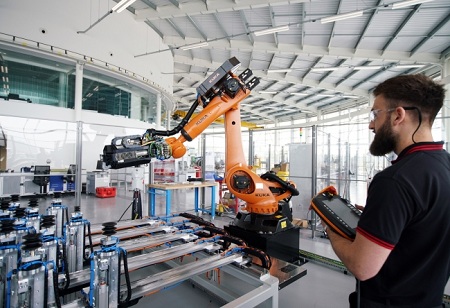
Automation and digital technology have led substantial transformations in the industrial industry over the years. The old idea of robots replacing human employees on the assembly line is progressively giving way to a more symbiotic interaction between humans and technology. Human-machine collaboration has developed as a critical component of contemporary production, transforming productivity, efficiency, and safety.
Manufacturing organizations have increased their production speed and efficiency thanks to the transition to automation. This has enabled them to minimize staff expenses and create more items in less time. With the shift to collaboration, producers may now utilize technology to collaborate and develop better goods. This includes using virtual reality, 3D printing, and artificial intelligence to produce solutions that will assist them in producing higher-quality products more quickly and effectively.
However, some contend that technology will never be able to replace the importance of human connection and that manufacturers will always require human employees to develop their goods. They say that human employees may offer innovation and insight into the production process that robots cannot. Manufacturing is the process of converting raw resources into final goods. It can be done by hand, by machine, or by a mix of both ways.
The Rise of Human-Centric Collaborative Robotics
Automation in manufacturing has typically been associated with the deployment of robots and other machines to handle repetitive and strenuous tasks. While this undoubtedly led to increased productivity and reduced human error, it also raised concerns about job displacement and the potential dehumanization of the workplace.
However, a new trend is emerging: the rise of human-centric collaborative robotics. Unlike traditional robots that work in isolation, these robots are designed to work alongside human workers, augmenting their capabilities rather than replacing them. Collaborative robots, also known as cobots, are equipped with advanced sensors and safety features that allow them to work safely near humans.
The advantages of collaborative robotics are multifaceted. Firstly, they can handle physically demanding tasks, leading to reduced worker fatigue and improved ergonomics. Secondly, cobots can assist with intricate operations that require precision, enhancing the overall quality of the manufacturing process. Moreover, by taking over mundane tasks, cobots free up human workers to focus on more creative and value-added activities, fostering a more fulfilling work environment.
This shift towards human-centric collaborative robotics demonstrates how manufacturers are recognizing the importance of striking a balance between automation and human expertise. Rather than displacing workers, collaboration enables the industry to create a harmonious blend of human intelligence and technological prowess.
The Emergence of Digital Twins and Augmented Reality (AR) in Manufacturing
Digital twins and augmented reality (AR) are two groundbreaking technologies that have begun to revolutionize manufacturing. These technologies promote collaboration by creating virtual replicas of physical assets and processes, offering a powerful means of improving efficiency and decision-making.
A digital twin is a virtual model that replicates the design, behaviour, and performance of a physical object or process. By incorporating real-time data from sensors, it allows manufacturers to monitor and analyze the performance of machines and production lines in real time. This digital representation enables better predictive maintenance, optimization of processes, and the ability to identify potential issues before they escalate.
Augmented reality, on the other hand, involves overlaying digital information onto the physical world. In the context of manufacturing, AR enables workers to access critical information, instructions, or visualizations directly on the factory floor. This technology can guide workers through complex assembly tasks, provide real-time information on machine parameters, and offer remote assistance to troubleshoot issues.
Together, digital twins and augmented reality foster collaboration by facilitating seamless communication and information-sharing among various stakeholders, including operators, engineers, and maintenance personnel. These technologies empower workers with valuable insights, enhance their decision-making capabilities, and promote a culture of continuous improvement within the organization.
Supply Chain Collaboration and Integration
In the past, manufacturing supply chains were often viewed as linear processes with limited communication and collaboration between different stakeholders. However, the modern manufacturing landscape is witnessing a paradigm shift, where supply chain collaboration and integration are becoming essential for success.
The advent of advanced data analytics, Internet of Things (IoT) devices, and cloud computing have enabled manufacturers to connect and share information across the entire supply chain. This heightened visibility allows companies to optimize inventory management, anticipate demand fluctuations, and streamline production schedules accordingly.
“Smart manufacturing technologies including automation, robotics, machine learning and the industrial internet of Things (IIOT) are assisting manufacturing companies towards a digitally advanced era. The necessity for businesses to become digitally advanced has increased to remain competitive in the market and deliver value to consumers. These smart technologies are helping businesses drive change and accelerate their capabilities to strengthen their hold in the market and enhance the scalability of their operations.” Says Channel Development Manager Universal Robots A/S Digital Marketing
Collaboration throughout the supply chain extends beyond the boundaries of the company. To ensure a more flexible and responsive supply chain, businesses are forging strategic alliances with suppliers, distributors, and even customers. These collaborations result in shorter lead times, cheaper inventory carrying costs, and more customer satisfaction by exchanging predictions, manufacturing plans, and inventory levels.
Furthermore, supply chain collaboration is emerging as a powerful instrument for implementing sustainable practices. Manufacturers and suppliers are collaborating to guarantee responsible raw material procurement, decrease waste, and lessen the environmental effect of their operations. Consumers place a higher value on ethical and ecological behaviours, and supply chain collaboration assists firms in meeting these changing needs.

